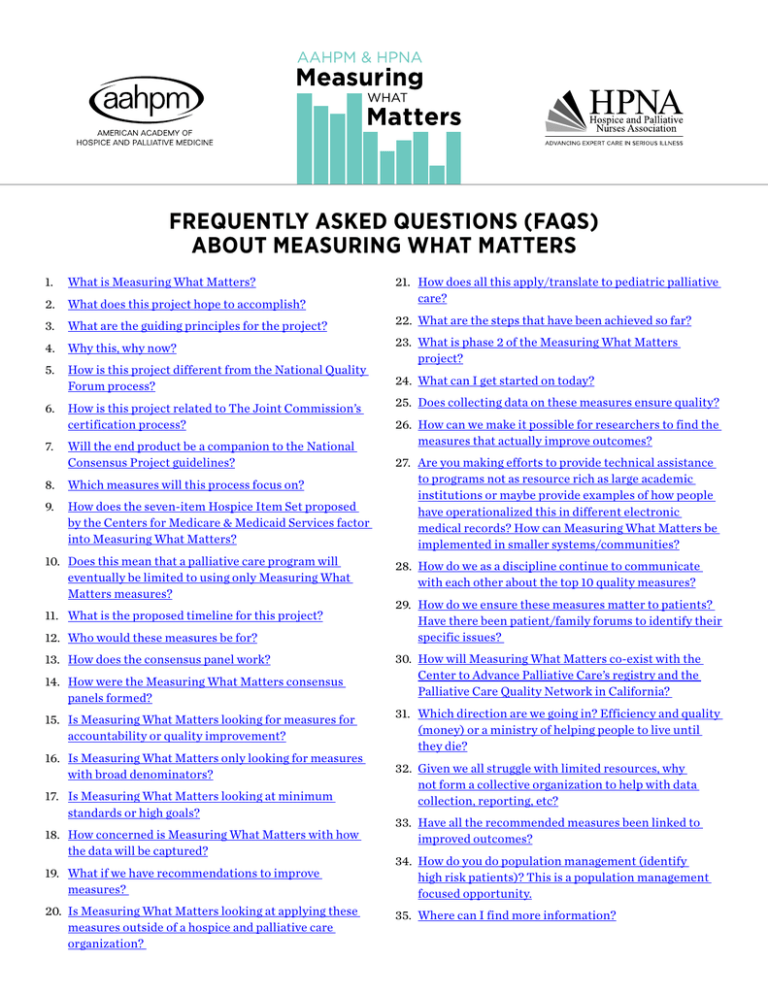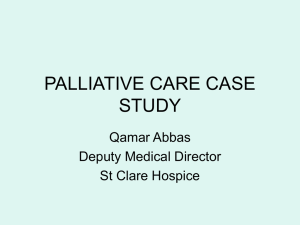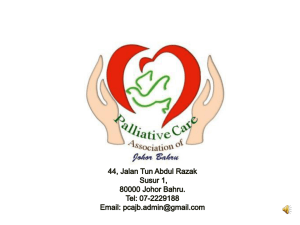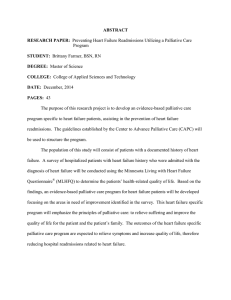Frequently Asked questions (FAqs) About MeAsuring WhAt MAtters
advertisement

Frequently Asked Questions (FAQs) About Measuring What Matters 1. What is Measuring What Matters? 2. What does this project hope to accomplish? 3. What are the guiding principles for the project? 4. Why this, why now? 5. How is this project different from the National Quality Forum process? 6. How is this project related to The Joint Commission’s certification process? 7. Will the end product be a companion to the National Consensus Project guidelines? 8. Which measures will this process focus on? 9. How does the seven-item Hospice Item Set proposed by the Centers for Medicare & Medicaid Services factor into Measuring What Matters? 10. Does this mean that a palliative care program will eventually be limited to using only Measuring What Matters measures? 11. What is the proposed timeline for this project? 12. Who would these measures be for? 13. How does the consensus panel work? 14. How were the Measuring What Matters consensus panels formed? 15. Is Measuring What Matters looking for measures for accountability or quality improvement? 16. Is Measuring What Matters only looking for measures with broad denominators? 17. Is Measuring What Matters looking at minimum standards or high goals? 18. How concerned is Measuring What Matters with how the data will be captured? 19. What if we have recommendations to improve measures? 20. Is Measuring What Matters looking at applying these measures outside of a hospice and palliative care organization? 21. How does all this apply/translate to pediatric palliative care? 22. What are the steps that have been achieved so far? 23. What is phase 2 of the Measuring What Matters project? 24. What can I get started on today? 25. Does collecting data on these measures ensure quality? 26. How can we make it possible for researchers to find the measures that actually improve outcomes? 27. Are you making efforts to provide technical assistance to programs not as resource rich as large academic institutions or maybe provide examples of how people have operationalized this in different electronic medical records? How can Measuring What Matters be implemented in smaller systems/communities? 28. How do we as a discipline continue to communicate with each other about the top 10 quality measures? 29. How do we ensure these measures matter to patients? Have there been patient/family forums to identify their specific issues? 30. How will Measuring What Matters co-exist with the Center to Advance Palliative Care’s registry and the Palliative Care Quality Network in California? 31. Which direction are we going in? Efficiency and quality (money) or a ministry of helping people to live until they die? 32. Given we all struggle with limited resources, why not form a collective organization to help with data collection, reporting, etc? 33. Have all the recommended measures been linked to improved outcomes? 34. How do you do population management (identify high risk patients)? This is a population management focused opportunity. 35. Where can I find more information? 1. What is Measuring What Matters? The AAHPM Quality and Practice Standards Task Force and the HPNA Research Advisory Group have partnered on a new initiative called Measuring What Matters, a consensus project aimed at identifying a recommended portfolio of cross-cutting performance measures for all hospice and palliative care programs (chaired by David Casarett, MD MA, and Sally Norton, PhD RN FAAN FNAP FPCN). The project will likely recommend a core set of five to 10 “basic” measures, an additional set of “advanced” measures, and a set of “aspirational” measure concepts needing further development. It is the hope that the resulting portfolio of measures will serve as the foundation for further development of hospice and palliative care quality projects nationally. 2. What does this project hope to accomplish? With the plethora of diverse quality measures available now, this project hopes to recommend five to 10 cross-cutting measures for palliative care programs to use for program improvement. The project panelists will sort through the dozens of published quality measures for hospice and palliative care to select a small portfolio of recommended measures for use across all settings. We hope to answer the question “How do you measure healthcare quality within and across palliative care programs?” 3. What are the guiding principles for the project? Some of the guiding principles under consideration for Measuring What Matters are (a) End products should ideally be companions to National Consensus Project guidelines (b) Recommend and develop population-level measures that are not site- or condition-specific, but are cross-cutting and apply to all patients in need of palliative care (whether primary or specialty). The measures would apply across settings—inpatient palliative care, outpatient palliative care, long-term care, home health, hospice inpatient, hospice home care. (c) Start with National Quality Forum-endorsed and other published measures and consider developing measure concepts where measurement gaps exist. 4. Why this, why now? Because few of the national quality programs currently include measures addressing palliative care concerns and goals, palliative care practitioners have been challenged to find applicable quality measures that can be benchmarked nationally. With the increased emphasis on quality measurement defined by the Affordable Care Act and increased focus on palliative care and hospice as programs that add value to patients and are cost effective to the healthcare system, this is an ideal time to gather experts in the field to achieve consensus on how to measure a quality palliative care program. 5. How is this project different from the National Quality Forum (NQF) process? NQF evaluates measures against four standardized measure evaluation criteria: importance to measure and report, scientific acceptability of measure properties, usability and feasibility, and composite evaluation criteria. Information regarding the criteria as well as guidance documents can be found on the NQF website. NQF Steering Committees review only the measures that are submitted to them and decide through a consensus process whether they meet the four requirements and rise to the level of being used in a national reporting program. Measuring What Matters will focus solely on palliative care, review the work that’s already been done in quality measurement in the field, and ask the experts what defines quality in a palliative care program. 6. How is this project related to The Joint Commission’s certification process? Launched in September 2011, The Joint Commission’s Advanced Certification Program for Palliative Care recognizes hospital inpatient programs that demonstrate exceptional patient- and family-centered care and optimize the quality of life for patients (both adult and pediatric) with serious illness. Currently, The Joint Commission is not prescriptive regarding the specific measures that are implemented within a palliative care program; the emphasis is on the use of performance measures for improving palliative care services. It is our hope that Measuring What Matters will be useful to inpatient palliative care programs (and all programs) by recommending a panel of cross-cutting performance measures to use for continuous quality improvement. 7. Will the end product be a companion to the National Consensus Panel guidelines? Yes, we hope so. The intent of Measuring What Matters is to collaborate with and gather input and engagement from other hospice and palliative care organizations and different constituent groups in order to truly represent consensus in our field. We’d like to build on strengths and concepts from the National Consensus Project process and end product. 8. Which measures will this process focus on? The project will begin by gathering existing published measures on hospice and palliative care, and perhaps expand some of their denominators to include all palliative care instead of being disease- or site-specific. The goal is a concise set of recommended measures that applies broadly to the entire population of patients with palliative care needs. Having a concise set of measures would begin to allow comparison across settings as well as benchmarking within specialty palliative care programs. We intend to start with National Quality Forum (NQF)-endorsed measures, then go beyond NQF to include measures that may not have the evidence or testing support needed for NQF endorsement (yet) but that represent a vital area of quality in palliative care. The first round of measures may include what can be measured now, followed by a second and third round of measures that may include what needs more research or field testing. 9. How does the seven-item Hospice Item Set (HIS) proposed by the Centers for Medicare & Medicaid Services factor into Measuring What Matters? AAHPM supports the implementation of the standard patient level data set with the seven measures recommended, the HIS. However, we are concerned about the fact that the HIS is not an integrated set of measures that have a common denominator and can be determined at a single point in time following admission and again at discharge. We hope to build on the merits of the proposed HIS and make Measuring What Matters a more integrated panel of measures for all palliative care programs, not just for hospices. 10. Does this mean that a palliative care program will eventually be limited to using only Measuring What Matters measures? Absolutely not. Measuring What Matters measures are intended to give the topline, big picture assessment of a palliative care program or of a health system’s palliative care performance. They are the kind of measures where just one or two might be included on the dashboard of a healthcare system, and several more on the dashboard of the specialty palliative care program. But those topline, 30,000-foot view measures can never tell the whole story. Additional performance improvement measures looking at structure, process, and outcomes will continue to be needed and used to focus in on the details and texture needed to drive improvement. These more detailed measures also serve as a laboratory for finding useful measures that might be added to the Measuring What Matters slate in the future. 11. What is the proposed timeline for this project? Because we feel that the time is now for such a project, we’re getting started right away. The project will likely have several phases. Our goal is to have the phase 1 product—a preliminary draft of a concise portfolio of measures that can be used immediately—ready to share soon after the 2014 AAHPM/HPNA Annual Assembly. Subsequent phases of the project would take on more complex tasks, such as developing a common palliative care dominator and field testing altered, expanded, or untested measures. 12. Who would these measures be for? The vision for the final portfolio of measures is that it be vetted by experts in the field and usable by a complete hospice and palliative care team, not just by the physician. 13. How does the consensus panel work? We have a Clinical User Panel (CUP; chaired by Joe Rotella, MD MBA FAAHPM, and Keela Herr, PhD RN AGSF FAAN) that is composed of measure users from different settings and specialties (including nursing, social work, chaplaincy, etc), and also a Technical Advisory Panel (TAP; chaired by Sydney Dy, MD, and Susan McMillan, PhD ARNP FAAN) to help review background materials and the environmental landscape. The TAP will help to identify the universe of measures to be prioritized, judge the technical strength of existing measures (such as reliability, validity, etc), and help with denominator creation. The CUP will prioritize measures based on their importance and usefulness to the field. We’ll also invite input from members of AAHPM and HPNA through a survey process, as well as collaborate with other organizations to solicit wider feedback once the initial portfolio of measures is chosen. 14. How were the Measuring What Matters consensus panels formed? Technical advisory panel members were selected by the leadership of AAHPM and HPNA, and are recognized as some of the best minds in quality measurement focusing on hospice and palliative care. Clinical user panel (CUP) members were nominated by AAHPM and HPNA leadership and quality committees and are meant to represent all of the different settings where hospice and palliative care occur, as well as different patient populations and illnesses; the CUP includes representation from social work, chaplaincy, grief counseling, consumer groups, and quality organization groups. The project also has oversight by the AAHPM Quality and Practice Standards Committee, the HPNA Research Advisory Group, staff liaisons to the Center to Advance Palliative Care, The Joint Commission and Visiting Nurses Associations of America, and a Virtual Focus Group/Response Panel made up of AAHPM and HPNA members who volunteered to participate. 15. Is Measuring What Matters looking for measures for accountability or quality improvement? This project aims to propose a portfolio of cross-cutting measures for quality improvement in clinical settings. We recognize that more palliative care measures are needed in accountability programs, but feel that a quality improvement portfolio is a necessary first step. Some measures we choose may not be ready for accountability or mandatory data collection, even though they are currently suitable for quality improvement purposes. Measures need to meet high standards and undergo rigorous testing for inclusion in accountability programs run by the Centers for Medicare & Medicaid Services, The Joint Commission, etc. Many of the measures we have reviewed for inclusion are suitable for internal purposes but need more testing and tweaking before they are ready for accountability. The recommendation from the technical advisory panel is that most of these measures are not ready for use in accountability programs. However, we recognize that just because these measures are not ready for accountability doesn’t mean they won’t be picked up and used for accountability. We acknowledge the tension between our goal of recommending measures for internal quality improvement and the urgent need to include palliative care friendly measures in accountability programs. 16. Is Measuring What Matters only looking for measures with broad denominators? Although the project aims for broad-based measures, few have been tested. Therefore, we included measures defined for very specific populations. Our consensus panels had the flexibility to rate the measures based on their own views of scientific soundness and meaningfulness to the field. You will see that several narrowly defined measures are included in the list for consideration because of their importance in measuring a gap in care. Currently, the field does not have a specified and tested denominator that reliably says “this is an appropriate patient for palliative care.” Developing such a denominator is a task for phase 2 of Measuring What Matters. 17. Is Measuring What Matters looking at minimum standards or high goals? The project is looking at measures to set minimum standards for what everyone ought to be doing. Our goal is to start measuring that first, then we’ll want to create higher standards later. 18. How concerned is Measuring What Matters with how the data will be captured? For any of these measures, some programs are going to have to make changes in how the data is captured; it’s unlikely that any system is already set up to capture all measures. Data capture will be challenging for most systems but well worth the quality improvement effort. 19. What if we have recommendations to improve measures? Our approach is that the first set of Measuring What Matters recommended measures is going to stand “as is” according to how they have been tested and published. We’re capturing your comments and recommendations, but our current task is to choose the top 10 measures from the pool of measures we have today. Recommendations from panelists and commenters will be shared with the measure developers. We will revisit these recommendations in phase 2 of Measuring What Matters. 20. Is Measuring What Matters looking at applying these measures outside of a hospice and palliative care organization? We want to focus on the patient. Therefore, our goal was to find measures that were flexible enough to apply across all settings. However, this was difficult because many measures do not apply in all settings. For now, we are working with what we have today. 21. How does all this apply/translate to pediatric palliative care? Many of the measures we reviewed may not fit in pediatric settings. Additional work needs to occur for pediatrics (neonatal and perinatal especially). This will be another task for phase 2. 22. What are the steps that have been achieved so far? 1) The Technical Advisory Panel rated published measures on their scientific soundness and referred a set of measures (N = 34) for review by the Clinical User Panel (CUP). 2) The CUP rated those measures based on three dimensions of meaningfulness: a. How MEANINGFUL is this for patients/families? b. How ACTIONABLE is this for providers/organizations? c. How large is the POTENTIAL IMPACT? 3) The CUP achieved consensus on their top 12 initial published measures. 4) In May 2014, the draft list was sent to AAHPM and HPNA members to elicit feedback and ask them to reduce the list of 12 measures down to 10. 5) Next steps: Share the results of the professional input, and then elicit wider feedback from other organizations, patients and families, and the general public. 23. What is phase 2 of the Measuring What Matters project? Phase two of the project will include creating a cross-cutting denominator, creating a unified measure set, and possibly participating in a registry or developing capacity for benchmarking nationally. We hope the final product will be leverage to bring programs into the future. It’s not about saving money but bringing value to the patients and families we serve. Eventually, aligning certain measures with national programs could enable benchmarking and rapid cycle quality improvement. 24. What can I get started on today? Today, we recommend aligning measures with existing requirements where possible: Hospices—start with measures already in the Hospice Item Set (HIS) Hospital-based palliative care—select from Measuring What Matters to meet The Joint Commission’s certification requirements 25. Does collecting data on these measures ensure quality? These are the best measures we’ve found, but measures alone do not define quality. We still need measures that relate priorities to improved outcomes. The goal of outcome measures can be very challenging and are limited in palliative care; that’s why we’re starting with what we have—mostly process measures. This is the first step in what will be a long (but hopefully not excessively long) process to arrive at a robust quality measuring, reporting, and improvement process throughout our field. 26. How can we make it possible for researchers to find the measures that actually improve outcomes? Accountability measures can quickly change care. National Quality Forum measure #0209 (the “Comfortable Dying” measure) was a required measure for hospices but was dropped. Everyone wants outcome measures, but the devil is in the details. Part of the Measuring What Matters project involves developing a companion paper on quality research priorities. And we hope to directly align this work with other national initiatives intended to define the impact in change in these measures so that we have the research data to inform our understanding of the relationship between quality improvement and patient outcomes. 27. Are you making efforts to provide technical assistance to programs not as resource rich as large academic institutions or maybe provide examples of how people have operationalized this in different electronic medical records? How can Measuring What Matters be implemented in smaller systems/communities? AAHPM and HPNA will continue working on compiling resources. The long-term plan is to create a toolkit to assist all types of programs in implementing Measuring What Matters. 28. How do we as a discipline continue to communicate with each other about the top 10 quality measures? Dissemination of information and adoption of the agreed upon measures will be a major challenge for our field, and we’ll be looking to our members to help spread the word. 29. How do we ensure these measures matter to patients? Have there been patient/family forums to identify their specific issues? This is a huge issue—we don’t have many truly patient-reported outcome measures. However, our palliative care measures are more patient centered than many measures in other areas of medicine. Many palliative care measures have been based on years of sound research into the patient and family experience. The emphasis on patient goals of care in our field has led to a sensitivity to including what patients and families value. That being said, there is still much to be done to make sure quality measures are sensitive to patient and family values. In this phase, we relied on clinicians to interpret “what matters” to patients. Our Clinical User Panel (CUP) is made up of providers from all settings where hospice and palliative care occur, as well as different patient populations and illnesses, to help represent different points of view; in addition, the CUP includes representation from social work, chaplaincy, grief counseling, consumer groups, and quality organization groups. As our work continues, we plan to elicit wider feedback from patients and families. 30. How will Measuring What Matters co-exist with the Center to Advance Palliative Care’s (CAPC) registry and the Palliative Care Quality Network (PCQN) in California? The idea is to come to consensus on 10 measures in the field, then work with the Centers for Medicare & Medicaid Services, CAPC, PCQN, and the Quality Data Collection Tool at Duke University to possibly incorporate the measures into those programs. 31. Which direction are we going in? Efficiency and quality (money) or a ministry of helping people to live until they die? We hope a balanced set of measures will help us do both: deliver the care people want and need in an efficient and effective way. But when there is tension between those two goals, we hope a focus on measuring, delivering, and improving on “what matters to patients and families” will be the guiding principle. 32. Given we all struggle with limited resources, why not form a collective organization to help with data collection, reporting, etc? Definitely a good idea—and something that will be considered in phase 2. 33. Have all the recommended measures been linked to improved outcomes? No. (See the description and background information of each measure for specifics on outcomes evidence, when available.) The evidence base for our field—although growing—is not yet robust enough to link all recommended processes directly to outcomes. We hope that getting many programs to coalesce around the Measuring What Matters measure set will help build the evidence for those that do have a strong impact on outcomes. 34. How do you do population management (identify high risk patients)? This is a population management focused opportunity. Another good question that is beyond the specific focus of MWM at this time. Both the identification of high risk patients and development of risk adjustors are tasks for later phases. 35. Where can I find more information? By contacting Katherine Ast, MSW LCSW, director, quality and research, AAHPM, at kast@aahpm.org.








